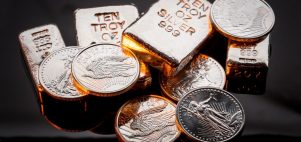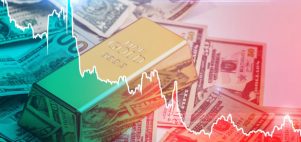(Kitco News) – After a significant rally Tuesday evening, the gold market has cooled considerably heading into the weekend, as market volatility subsides and renewed interest emerges in the U.S. dollar and bond yields.
However, while gold is seeing some profit-taking—and what some analysts have described as a much-needed consolidation—many do not expect this week’s top to represent the high for the year.
After a strong start to the week, gold is poised to end Friday with a sharp decline. Spot gold last traded at $3,284 an ounce, down more than 1% on the week. Prices are also down 6% from Tuesday’s intra-day all-time high of $3,500 an ounce.
Jesse Colombo, an independent precious metals analyst and founder of the BubbleBubble Report, described gold’s price action as a healthy pullback. He added that he could see gold consolidating through the summer and is looking for prices to hold support around $3,000 an ounce.
“I believe [gold is] still in the early stages of this bull market. Pullbacks are normal, regular occurrences even in the most epic bull markets,” he said. “Given this view, I would still not sell any of my gold bullion, but I would take a more defensive short-term approach on futures or [mining equities].”
Analysts note that renewed selling pressure in gold comes as fears over the global economy begin to ease. While there is still plenty of worry swirling through financial markets, some economists argue that economic uncertainty has peaked.
“Although no official trade deals have been reached yet, negotiation progress is a step in the right direction that helps change the narrative from how high tariff rates could be—as presented on ‘Liberation Day’—to how low they could go via trade deals,” said Adam Turnquist, Chief Technical Strategist for LPL Financial, in a note Wednesday. “Furthermore, the transition to trade negotiations suggests peak economic uncertainty (and perhaps fear) was likely reached earlier this month.”
Still, some analysts have pointed out that while market tensions have eased, uncertainty remains high enough to support gold prices at current levels. While President Donald Trump has claimed his administration has begun trade talks with China, the Chinese government has denied it.

Kelvin Wong, Senior Market Analyst at OANDA, said he doesn’t believe gold’s rally is over.
“If there are still no breakthroughs between U.S.-China trade negotiations, and more sector-based U.S. tariffs are introduced, the odds of greater uncertainty in business planning and stagflation risk in the U.S. will increase. This, in turn, would weaken the U.S. dollar and further boost the value of gold,” he said. “Overall, the medium-term and major uptrend phases for gold remain intact, with the next medium-term resistances at US$3,670/750 and US$3,890, supported by the weaker U.S. dollar and the fading of the U.S. ‘exceptionalism’ theme.”
Lukman Otunuga, Senior Market Analyst at FXTM, describes gold’s price action as a bout of profit-taking but adds that the fundamental forces supporting gold remain in place.
“The week ahead is stacked with major U.S. data and corporate earnings, which may shape overall sentiment. The latest U.S. GDP, the Fed’s preferred inflation gauge, and the U.S. jobs report could influence Fed cut bets—impacting gold prices as a result,” he said. “Talking technicals, a breakdown below $3,250 may open the door toward $3,170. Should $3,250 prove reliable support, prices may rebound back toward $3,390 and $3,500.”
Thu Lan Nguyen, Head of FX and Commodity Research at Commerzbank, said she sees gold’s selloff as a temporary setback within the broader uptrend.
“It remains unclear when and in what form an agreement with the Chinese leadership is possible—there have been different statements on this from Trump, U.S. Treasury Secretary Scott Bessent, and Beijing—so gold is likely to remain in demand as a safe haven for the time being,” she said. “In addition to the statements from the White House, attention will now focus on economic data from the U.S. If these already show clear signs of a slowdown due to U.S. tariff policy, the price of gold could quickly rise again.”
Employment data will be the focal point for markets next week, as April’s nonfarm payrolls report will show how much of an impact America’s tariff policies and austerity measures have had on the labor market.
However, not all analysts are bullish on gold. Philip Strieble, Chief Market Strategist at Blue Line Futures, said it may be time for investors to look further down the value chain in the precious metals market.
He said he expects silver to start outperforming gold if financial markets have reached peak uncertainty.
“If industrial demand is able to find its feet, then we should see renewed demand for silver,” he said. “We already see some investors rotating out of gold and into silver.”
This week, the gold-silver ratio hit a multi-year high of 107 points; however, gold’s selloff has pushed the ratio sharply lower, and it is on track to end the week at 99 points.











